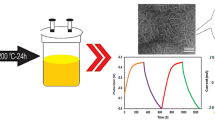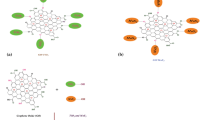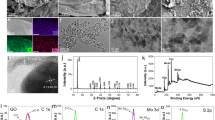Abstract
In this study, an MoS2/graphene composite is fabricated from bulk MoS2 and graphite rod via a facile electrochemical exfoliation method. The as-prepared samples are characterized by X-ray diffraction, field emission scanning electron microscopy, Fourier transform infrared spectroscopy and ultraviolet-visible spectroscopy techniques to confirm the formation of the MoS2/graphene composite. The electrochemical behavior of the MoS2/graphene composite is evaluated through cyclic voltammetry, galvanostatic charge/discharge and electrochemical impedance spectroscopy. It exhibits high specific capacitance of 227 F g−1 as compared with the exfoliated graphene (85 F g−1) and exfoliated MoS2 (70 F g−1) at a current density of 0.1 A g−1. This can be attributed to the synergistic effect between graphene and MoS2. Moreover, it displays high electrochemical stability and low electrical resistance.

Graphical abstract









Similar content being viewed by others

References
Quan Q, Lin X, Zhang N et al (2017) Graphene and its derivatives as versatile templates for materials synthesis and functional applications. Nanoscale 9:2398–2416
Lee SP, Ali GAM, Algarni H et al (2019) Flake size-dependent adsorption of graphene oxide aerogel. J Mol Liq 277:175–180
Wang J, Luo Q, Luo C et al (2017) High-performance supercapacitor electrode based on a nanocomposite of polyaniline and chemically exfoliated MoS2 nanosheets. J Solid State Electrochem 21:2071–2077
Jia W, Tang B, Wu P (2018) Nafion-assisted exfoliation of MoS2 in water phase and the application in quick-response NIR light controllable multi-shape memory membrane. Nano Res 11:542–553
Li Y, Wang H, Xie L et al (2011) MoS2 nanoparticles grown on graphene: an advanced catalyst for the hydrogen evolution reaction. J Am Chem Soc 133:7296–7299
Tuteja SK, Duffield T, Neethirajan S (2017) Liquid exfoliation of 2D MoS2 nanosheets and their utilization as a label-free electrochemical immunoassay for subclinical ketosis. Nanoscale 9:10886–10896
Ganatra R, Zhang Q (2014) Few-layer MoS2: a promising layered semiconductor. ACS Nano 8:4074–4099
Aboelazm EAA, Ali GAM, Algarni H et al (2018) Flakes size-dependent optical and electrochemical properties of MoS2. Curr Nanosci 14:416–420
Theerthagiri J, Senthil R, Senthilkumar B et al (2017) Recent advances in MoS2 nanostructured materials for energy and environmental applications–a review. J Solid State Chem 252:43–71
Gusmão R, Sofer Z, Luxa J et al (2019) Antimony chalcogenide van der Waals nanostructures for energy conversion and storage. ACS Sustain Chem Eng 7:15790–15798
Zhang S, Song X, Liu S et al (2019) Template-assisted synthesized MoS2/polyaniline hollow microsphere electrode for high performance supercapacitors. Electrochim Acta 312:1–10
Raccichini R, Varzi A, Passerini S et al (2015) The role of graphene for electrochemical energy storage. Nat Mater 14:271–279
Ali GAM, Makhlouf SA, Yusoff MM et al (2015) Structural and electrochemical characteristics of graphene nanosheets as supercapacitor electrodes. Rev Adv Mater Sci 40:35–43
Liu N, Kim P, Kim JH et al (2014) Large-area atomically thin MoS2 nanosheets prepared using electrochemical exfoliation. ACS Nano 8:6902–6910
Ambrosi A, Pumera M (2018) Electrochemical exfoliation of MoS2 crystal for hydrogen electrogeneration. Chem Eur J 24:18551–18555
Jia Y, Wan H, Chen L et al (2017) Hierarchical nanosheet-based MoS2/graphene nanobelts with high electrochemical energy storage performance. J Power Sources 354:1–9
Achee TC, Sun W, Hope JT et al (2018) High-yield scalable graphene nanosheet production from compressed graphite using electrochemical exfoliation. Sci Rep 8:14525
Liu Y, Zhao Y, Jiao L et al (2014) A graphene-like MoS2/graphene nanocomposite as a highperformance anode for lithium ion batteries. J Mater Chem A 2:13109–13115
Chen Y, Ma W, Cai K et al (2017) In situ growth of polypyrrole onto three-dimensional tubular MoS2 as an advanced negative electrode material for supercapacitor. Electrochim Acta 246:615–624
Kee CW (2015) Assignment of O–O and Mo=O stretching frequencies of molybdenum/tungsten complexes revisited. J Chem 2015:439270–439279
da Silveira Firmiano EG, Rabelo AC, Dalmaschio CJ et al (2014) Supercapacitor electrodes obtained by directly bonding 2D MoS2 on reduced graphene oxide. Adv Energy Mater 4:1301380–1301387
Zhou K, Jiang S, Bao C et al (2012) Preparation of poly(vinyl alcohol) nanocomposites with molybdenum disulfide (MoS2): structural characteristics and markedly enhanced properties. RSC Adv 2:11695–11703
Teo EYL, Ali GAM, Algarni H et al (2019) One-step production of pyrene-1-boronic acid functionalized graphene for dopamine detection. Mater Chem Phys 231:286–291
Liu H, Chen B, Liao L et al (2019) The influences of mg intercalation on the structure and supercapacitive behaviors of MoS2. J Mater Sci 54:13247–13254
Tanhaei M, Mahjoub AR, Safarifard V (2019) Energy-efficient sonochemical approach for the preparation of nanohybrid composites from graphene oxide and metal-organic framework. Inorg Chem Commun 102:185–191
Zhang R, Wan W, Li D et al (2017) Three-dimensional MoS2/reduced graphene oxide aerogel as a macroscopic visible-light photocatalyst. Chin J Catal 38:313–320
Zhou Y, Zhang X, Zhang Q et al (2014) Role of graphene on the band structure and interfacial interaction of Bi2WO6/graphene composites with enhanced photocatalytic oxidation of NO. J Mater Chem A 2:16623–16631
Ali GAM, Fouad OA, Makhlouf SA (2013) Structural, optical and electrical properties of sol–gel prepared mesoporous Co3O4/SiO2 nanocomposites. J Alloys Compd 579:606–611
Wang Q, Huang J, Sun H et al (2018) MoS2 quantum dots@TiO2 nanotube arrays: an extended-spectrum-driven photocatalyst for solar hydrogen evolution. ChemSusChem 11:1708–1721
Abdi MM, Ekramul Mahmud HNM, Abdullah LC et al (2012) Optical band gap and conductivity measurements of polypyrrole-chitosan composite thin films. Chin J Polym Sci 30:93–100
Li Z, Xiang K, Xing W et al (2015) Reversible aluminum-ion intercalation in prussian blue analogs and demonstration of a high-power aluminum-ion asymmetric capacitor. Adv Energy Mater 5:1401410
Wang R, Wang S, Peng X et al (2017) Elucidating the intercalation pseudocapacitance mechanism of MoS2–carbon monolayer interoverlapped superstructure: toward high-performance sodium-ion-based hybrid supercapacitor. ACS Appl Mater Interfaces 9:32745–32755
Sarkar D, Das D, Das S et al (2019) Expanding interlayer spacing in MoS2 for realizing an advanced supercapacitor. ACS Energy Letters 4:1602–1609
Thalji MR, Ali GAM, Algarni H et al (2019) Al3+ ion intercalation pseudocapacitance study of W18O49 nanostructure. J Power Sources 438:227028
Aboelazm EAA, Ali GAM, Chong KF (2018) Cobalt oxide supercapacitor electrode recovered from spent lithium-ion battery. Chem Adv Mater 3:67–74
Ali GAM, Fouad OA, Makhlouf SA et al (2014) Co3O4/SiO2 nanocomposites for supercapacitor application. J Solid State Electrochem 18:2505–2512
Li Z, Zhou Z, Yun G et al (2013) High-performance solid-state supercapacitors based on graphene-ZnO hybrid nanocomposites. Nanoscale Res Lett 8:473
Fu M, Ge C, Hou Z et al (2013) Graphene/vanadium oxide nanotubes composite as electrode material for electrochemical capacitors. Phys B Condens Matter 421:77–82
Zhu J, He J (2012) Facile synthesis of graphene-wrapped honeycomb MnO2 nanospheres and their application in supercapacitors. ACS Appl Mater Interfaces 4:1770–1776
Chen S, Zhu J, Wu X et al (2010) Graphene oxide-MnO2 nanocomposites for supercapacitors. ACS Nano 4:2822–2830
Wang Q, Jiao L, Du H et al (2014) Fe3O4 nanoparticles grown on graphene as advanced electrode materials for supercapacitors. J Power Sources 245:101–106
Wu M-S, Lin C-J, Ho C-L (2012) Multilayered architecture of graphene nanosheets and MnO2 nanowires as an electrode material for high-performance supercapacitors. Electrochim Acta 81:44–48
Prabukumar C, Mohamed Jaffer Sadiq M, Krishna Bhat D et al (2019) SnO2 nanoparticles functionalized MoS2 nanosheets as the electrode material for supercapacitor applications. Mater Res Express 6:085526
Zhang F, Tang Y, Liu H et al (2016) Uniform incorporation of flocculent molybdenum disulfide nanostructure into three-dimensional porous graphene as an anode for high-performance lithium ion batteries and hybrid supercapacitors. ACS Appl Mater Interfaces 8:4691–4699
Patil S, Harle A, Sathaye S et al (2014) Development of a novel method to grow mono−/few-layered MoS2 films and MoS2–graphene hybrid films for supercapacitor applications. CrystEngComm 16:10845–10855
Xiao W, Zhou W, Feng T et al (2016) Simple synthesis of molybdenum disulfide/reduced graphene oxide composite hollow microspheres as supercapacitor electrode material. Materials 9:783–796
Zheng S, Zheng L, Zhu Z et al (2018) MoS2 nanosheet arrays rooted on hollow rGO spheres as bifunctional hydrogen evolution catalyst and supercapacitor electrode. Nano-Micro Lett 10:62–72
Wang J, Wu Z, Hu K et al (2015) High conductivity graphene-like MoS2/polyaniline nanocomposites and its application in supercapacitor. J Alloys Compd 619:38–43
Ali GAM, Manaf SAA, Divyashree A et al (2016) Superior supercapacitive performance in porous nanocarbons. J Energy Chem 25:734–739
Ali GAM, Yusoff MM, Shaaban ER et al (2017) High performance MnO2 nanoflower supercapacitor electrode by electrochemical recycling of spent batteries. Ceram Int 43:8440–8448
Acknowledgments
The authors would like to acknowledge the funding from the Ministry of Education Malaysia in the form of FRGS [RDU1901186: FRGS/1/2019/STG07/UMP/02/6] and Universiti Malaysia Pahang grant RDU170357. Moreover, the authors extend their appreciation to King Khalid University, the Ministry of Education–Kingdom of Saudi Arabia for supporting this research through a grant (RCAMS/KKU/002-18) under the Research Center for Advanced Material Science. In addition, Dr. Gomaa A. M. Ali would like to express his thanks to SESAME Synchrotron (Allan, Jordan), which through the EU-funded project OPEN SESAME provided training on material characterization testing and data analysis.
Author information
Authors and Affiliations
Corresponding author
Ethics declarations
Conflict of interest
The authors declare that they have no conflict of interest.
Additional information
Publisher’s note
Springer Nature remains neutral with regard to jurisdictional claims in published maps and institutional affiliations.
Highlights
• An MoS2/graphene composite is obtained via one-step electrochemical exfoliation.
• The MoS2/graphene composite is employed as electrode material for supercapacitor application.
• MoS2/graphene shows high specific capacitance of 227 F g−1 (threefold > MoS2 and graphene).
• MoS2/graphene shows high electrochemical stability and low electrical resistance.
Electronic supplementary material
ESM 1
(DOCX 410 kb)
Rights and permissions
About this article
Cite this article
Ali, G.A.M., Thalji, M.R., Soh, W.C. et al. One-step electrochemical synthesis of MoS2/graphene composite for supercapacitor application. J Solid State Electrochem 24, 25–34 (2020). https://doi.org/10.1007/s10008-019-04449-5
Received:
Revised:
Accepted:
Published:
Issue Date:
DOI: https://doi.org/10.1007/s10008-019-04449-5



